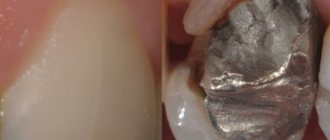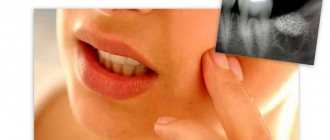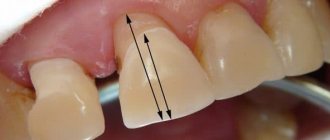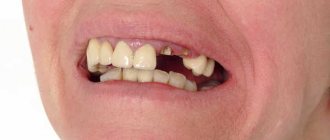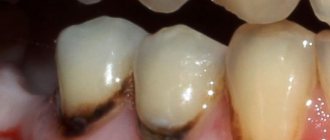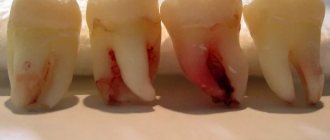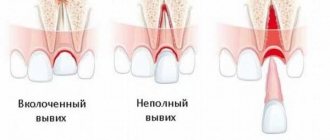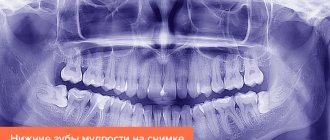13421
Many people face the problem of cracked teeth. When the protective layer (enamel) becomes thinner, the risk of injury increases.
This entails not only an unaesthetic appearance, but the development of possible dental diseases.
What measures should be taken to eliminate the crack? Is it possible to solve this problem on my own?
Why might a tooth crack?
Poor nutrition causes tooth enamel to weaken. Often the problem is faced by people who neglect foods high in calcium and fluoride. If the enamel is weak, any factors can lead to cracks. So, some people have bad habits of cracking nuts or opening bottles with their teeth. Common household trauma can also contribute to the appearance of a crack. Dental problems are often found among athletes (boxers, wrestlers).
If a tooth cracks in a dream, it is possible that the patient suffers from bruxism. This is grinding your teeth in your sleep. The patient may have a hereditary predisposition to bruxism. Also, the disease often develops against the background of stress or overwork. Grinding leads to increased wear of hard tooth tissues. The enamel is damaged and cracks appear. Therapy is carried out not only by a dentist, but also by a psychologist. Sometimes the patient is prescribed hypnosis sessions.
The main causes of dental cracks
There are a number of factors that can cause such dental damage:
- lack of vitamins and minerals in the body necessary for the formation of strong tooth enamel, which is a consequence of poor nutrition;
- eating foods with high levels of acidity and sugar, which negatively affects the condition of the enamel, gradually corroding it;
- simultaneous consumption of very hot foods and cold drinks, which leads to a sharp temperature contrast in the oral cavity, causing the enamel to crack;
- bad habits of gnawing hard objects and foods (nuts, seeds), which in case of sudden efforts will lead to chipping of the enamel;
- dental injuries due to impact;
- diseases and spasms of the masticatory muscles, which is expressed in uncontrolled compression and movement of the jaws and has a negative mechanical effect on the enamel;
- side effects from medications due to their excessive use;
- medical errors made by the dentist during treatment procedures.
If no action is taken, a crack in the tooth may affect the root.
In some cases, it is difficult to find a crack on your own , which is quite possible if, for example, the enamel on a front tooth is cracked. In other cases, it would be wiser to rely on the opinion of your attending physician after reviewing the x-ray data. After all, you may not even suspect the presence of an injury if, for example, it is a consequence of unprofessional treatment in the previous period.
If damage appears soon after a filling or crown is placed on a given tooth, you should immediately visit a dentist . This way you can avoid further complications, as well as save your money on replacing a low-quality filling or crown.
When a crack appears, it is necessary to eliminate the load on the affected tooth . The debris puts pressure on the pulp, as a result of which an inflammatory process can begin, which is fraught with further complications. When an open wound appears, access to the blood and nerves is created for various infections. This, in turn, may lead to the need to remove the pulp. Therefore, it is extremely important to visit your dentist in advance to avoid oral diseases, in particular periodontal disease.
You may not notice a crack in your tooth right away, so visit your dentist regularly
Types of cracks
If a tooth has cracked, you cannot put off visiting the dentist. The absence of pain is not a reason to refuse treatment. Every day the pathological process will worsen. The method of treatment will directly depend on how exactly the tooth cracked. The most dangerous are vertical cracks. As a rule, in such cases the molar cannot be saved and must be removed.
In case of household injuries, as a rule, horizontal cracks are diagnosed. In most cases, the tooth can be built up. If the crack is observed closer to the gum, chipping is possible. Diagonal cracks occur when a molar is damaged at an angle. In this case, you cannot do without professional dental care. It is impossible to predict the consequences of damage if the inside of a tooth is cracked. The injury is not visible externally. Damage can most often be detected during MRI or X-ray diagnostics.
Root crack is the rarest pathology. As a rule, such damage develops against the background of trauma. It is rarely possible to save a tooth.
Treatment of cracks and splits
The treatment tactics for a cracked tooth are determined by the doctor, taking into account the depth and extent of the damage, the general condition of the enamel and tissues of the entire oral cavity. There are several effective therapy methods.
- enamel strengthening is carried out if the crack is relatively small and is located on the surface: the dentist will resort to the use of special strengthening agents. A mixture containing calcium and fluoride is applied to the enamel for a certain time, on average for 2 weeks. This will strengthen it and prevent further damage.
- composite building for minor cracks and chipping of part of the enamel along with dentin. Allows you to restore color and shape,
- veneering is a modern method of treatment in cases where there are multiple microdamages to the enamel. The method involves processing tissue and fixing special plates that will help hide the defect,
- endodontic treatment is required in more serious cases - fractures, damage to the root system, deep cracks. In the vast majority of cases, the pulp is removed even in the absence of clinical symptoms of its inflammation. This is explained by the fact that open access to the neurovascular bundle provokes the proliferation of pathogenic bacteria. Even if there are no symptoms of pulpitis, microorganisms can already begin to multiply in soft structures, and if the disease manifests itself after restoration of its form, this will entail unpleasant consequences and the need to undergo treatment again, this time with depulpation,
- a stump inlay or installation of pins is required if the tooth has broken off at the root and nothing remains of the crown. In this case, either an artificial crown is placed on top, or a composite build-up is performed.
We invite you to familiarize yourself with the Best Oral Irrigators Based on User Reviews
Enamel crack
Such injuries are diagnosed in almost everyone. Cracks can be vertical, horizontal or vertical. A common cause of such damage is eating food that is too cold or hot. Enamel cracks cause serious discomfort. The patient begins to react to sour and sweet foods. Pain occurs when eating hot liquid foods.
Discomfort is not the only unpleasant moment. Dyes from food easily penetrate into the enamel through the resulting crack. As a result, teeth lose their former attractiveness. In addition, pathogenic bacteria penetrate into the body of the tooth through a small hole. The risk of developing caries increases significantly. Therefore, if a tooth is cracked, you should make an appointment with the dentist on the same day.
Causes
Teeth most likely to break are previously treated teeth with large cavities or with pulp removed.
Cracks and chips appear during impacts and increased loads. But even minor impacts can cause injury if the enamel is weakened. Factors that provoke breakdown include:
- Incorrect treatment: too large a filling, incorrectly installed pin, mismatch between the dentures and the bite.
- Lack of fluorine, phosphorus and calcium.
- Bad habits: biting threads, nails, gnawing nuts, seeds, packaging.
- Unhealthy diet: an abundance of sour and sweet foods. The strength of the enamel is also affected by the absence of solid foods in the daily diet - carrots, apples.
- Increased acidity of saliva.
- Sudden changes in temperature. Microcracks form on the enamel if you wash down cold food with hot drinks and vice versa.
- Impacts and injuries to the jaw.
- Do-it-yourself whitening. Hard abrasive particles scratch the enamel and cause cracks to form.
- Parafunctions of the masticatory muscles – bruxism.
Important! Teeth most likely to break are previously treated teeth with large cavities or with pulp removed. This is due to a violation of the integrity of the enamel layer and a violation of the blood supply.
The tooth split in half
Such damage is possible in case of serious domestic injuries or in those who are used to cracking nuts or opening bottles with their teeth. This significantly increases the risk of complications. The problem is that during damage the pulp is exposed. If pathogenic bacteria enter the nerve of a tooth, it must be removed.
Things are more complicated if the crack goes deep into the gums. A specialist may decide to remove both parts of the root. If it is not possible to build up the tooth, a crown or bridge will be installed in the future.
crack at the root - remove?
Moderator: Lesya
Read also: A pin in a tooth breaks, what to do?
crack at the root - remove?
Post by DmitryN » Wed Aug 15, 2012 15:39
In a private clinic, after a small chip, tooth 6 (46, an old problematic pulpless tooth) was prepared for prosthetics - an inlay and a metal-ceramic crown. The canals were partially filled, an impression was taken, and a temporary filling was inserted. The insertion of the inlay was scheduled after 9 days, but about a week later the prepared tooth began to sag a little. When the doctor removed the temporary filling to insert the tab, there was slight bleeding from the distal root and pain was felt. Examined by a therapist. She said that when the instrument is inserted, there is slight bleeding from two channels, therefore, most likely there is a crack. They sent it for deletion, which made us very upset, because... I wanted to preserve my roots. The picture shows a chipped tooth before filling and after filling, when there was bleeding. I wanted to clarify two questions: 1) do you really need to delete it, or are there any options with the tab? 2) what is better to place an implant (and which one) or a bridge with depulpation of the healthy five and a crown on the dead seven (doctors suggest)? The tooth hurts a little when pressed. Thanks in advance. Based on your answer, I will decide what to do next and where to get treatment.
Re: crack at the root - remove?
Post by Lesya » Wed Aug 15, 2012 21:49
Good evening. Yes, a root crack is a serious problem, especially when it comes to placing a tab on these roots. If there is indeed a crack or perforation in the root, the main problem is that blood and fluid will leak from this place, thereby soon this tab will become cemented and the crown will fall out. That's why the doctor started talking about removal. If there is no chance of sealing this crack and being sure that it will work, then it’s a pity to charge you money for an inlay and a crown. Now there are materials that make it possible to hermetically close perforations, but it all depends on the size of the crack or perforation.
I cannot tell you what to do, since I personally cannot check the tooth. If you are in doubt, it is better to show up to someone else. Let you have the opinions of at least two general practitioners. If the second one says that there is a perforation (or crack), then it is better to remove the tooth. Since any prosthetics for a cracked tooth will obviously be without a guarantee and most likely not successful. That is, at best, a year, then the root will crack and everything will collapse. If you are ready to take a risk, then you can try to seal the MTA perforations (if they are not large), do prosthetics without a guarantee and see what happens next. In this situation, the main thing is not to combine the 6th tooth with 7 crowns, let each one be on its own. So at least you don’t risk having to redo two teeth at once if the root cracks completely.
If the tooth is removed: what to do next? The 7th tooth is in such a condition that it also needs prosthetics. Most of the tooth is already a filling, and in the absence of the main chewing tooth (6), it will begin to crumble under the load. That is, it will have to be covered with a crown. And then it all comes down to finances and the condition of the 5th tooth. If the 5th tooth is without a filling, without caries, and you can afford to pay for an implant, then, of course, it is better to leave the 5th tooth alive and not make a bridge. If there is already caries on it, it is large and you understand that implantation is not yet possible for you, it is better to make a ceramic bridge, preparing the 5th tooth for this. Therefore, for now, I would advise having the 6th tooth checked by another doctor, listening to another opinion and only then deciding what to do. But you need to consult in person, since the decision to delete is never made solely on the basis of the image. You must see it with your own eyes and hands. how bad is everything there?
If one part of the tooth is loose
If a tooth is cracked and loose, the patient will be prescribed an X-ray examination of the damaged area. The specialist must assess the extent of the lesion. If the injury does not result in a transverse root fracture, the specialist will try to save the tooth. The moving part is removed and the pin is installed. The tooth is built up to normal size using composite materials.
If the pin cannot be installed, the doctor may decide to install a photopolymer filling. Next, the result is fixed with a crown.
Treatment methods
A tooth root fracture is one of the most difficult cases for a practicing dentist.
What makes treatment especially difficult is that the defect is localized inside the gum, and this makes medical procedures very difficult. More often, tooth root fracture occurs in people over 40 years of age, although people of any age category are not insured against it. The root acts not only as a support for the tooth - it contains vessels that nourish the tissue, so it is extremely important to try to maintain its integrity. Ignoring injuries can lead to complications, including tooth loss.
https://www.youtube.com/watch?v=dPCaW3wFI5s
The most difficult to treat are oblique and comminuted fractures. Typically, with such fractures, the tooth must be removed. After extraction, they wait some time for the gums to heal, and then proceed with prosthetics. At the same time, you shouldn’t wait too long either, because a long absence of a dental unit is fraught with malocclusion, as well as the occurrence of periodontal disease.
If the fracture is located in the middle part, the tooth cavity is opened, the pulp is removed from it, the canals are filled, and the root fragments are combined with each other using pins. If the root breaks in the immediate vicinity of the apex, it is enough to seal the canal.
If a baby tooth is cracked
Kids are eager to taste everything, run and jump a lot. Increased activity often leads to injury. Why do children's teeth crack? There is not yet a sufficient amount of calcium in the children's body; the enamel in young patients is much weaker. If your child's tooth has cracked, you cannot put off visiting the dentist. The doctor must first make sure that the permanent tooth buds are not damaged.
If a baby tooth is cracked, your baby should not be given too hot or cold drinks. It is also worth explaining to the child that chewing hard foods on the side where the injury occurred is temporarily prohibited. If the child is still too small, you should give him pureed food. If pain is present, Nurofen and Paracetamol syrups will help improve the baby’s condition before visiting a doctor.
Necessary actions
Small defects are not always visible. The appearance of itching or discomfort while eating should be the basis for a visit to the dentist. First of all, the doctor will send the patient for an x-ray; without it, it is impossible to determine the extent of the problem.
Based on the results of the examination, the dentist will decide on saving the tooth, assess the condition of the root, and prescribe adequate treatment.
Important! Any damage is a reason to eliminate the load on the tooth.
If it is not possible to visit a doctor on the day unpleasant symptoms appear, give yourself first aid:
- Rinse your mouth with an antiseptic; pharmaceutical solutions or herbal decoctions are suitable. (Chlorhexidine, Furacilin, Miramistin)
- For pain relief, take an analgesic (Nurofen, Ibuprofen, Analgin, Pentalgin).
- Avoid dislodging debris as it can damage the gums. To do this, do not touch the tooth with your hands or tongue, and avoid its contact with food.
- Avoid sudden temperature changes.
We suggest you read: Pain in the eye and jaw on one side
Please note that these are temporary measures and you cannot avoid consulting a dentist.
Is it possible to save a molar?
If a tooth cracks, what should you do? Will it be possible to save him? A qualified doctor can answer this question after a thorough examination. The specialist can use a special probe, coloring reagents, and perform palpation. An x-ray will help determine the depth of the injury.
If a tooth splits into two parts, it will most likely have to be removed. A crown or dental implant will be installed in place of the molar. Bridges are also widely used. If a tooth is cracked but not loose, it may be possible to save it.
There is a much greater chance of saving a tooth if the patient seeks help immediately after the crack appears. The doctor assesses the condition of the tooth and prescribes appropriate therapy. There are several ways to strengthen tooth enamel and restore the appearance of your smile.
Symptoms of a broken tooth under the crown
Signs that a tooth under a crown has broken:
- the structure broke off along with the stump;
- the prosthesis is loose;
- The dental unit hurts after mechanical impact (impact), the pain does not go away for a long time.
In most cases, it is impossible to restore the dentition using an old veneer. It is often damaged from the moment the tooth is fractured. Prosthetics require additional procedures, pinning or installation of a stump inlay. Because of this, a design with different characteristics is required.
The better the prosthesis is installed, the less likely it is that the tooth under the crown will break. The purpose of the design is to protect the walls of the prepared unit. Don't neglect regular visits to the dentist. You need to carefully monitor the behavior of the prosthesis. If there is an unpleasant odor from under the crown or slight wobbling, they objectively assess the problem and re-prosthetize the tooth before it breaks.
Fluoridation of teeth
The procedure is carried out to strengthen tooth enamel. It is indicated for those who have a predisposition to the development of caries. It is also worth making an appointment with a specialist for those who suffer from increased tooth sensitivity. This technique is suitable for patients who have cracks in their tooth enamel. Strengthening is carried out using special solutions with a high content of fluoride ions. Teeth coated with such a substance are protected from harmful environmental factors. In addition, fluoride ions prevent pathogenic bacteria from accumulating on the teeth.
Fluoridation is a completely painless procedure. It is also prescribed to young children whose teeth often break or darken. Fluoridation can be simple or deep. In the first case, a special spoon is used that resembles a dental cast. This instrument is filled with a medicinal substance and applied to the teeth for 15-20 minutes. After some time, the manipulations can be repeated.
Deep fluoridation is a more effective method. Fluoride and calcium penetrate into the pores of the tooth. The molars become really strong. It is almost impossible to damage them using mechanical force.
Features and localization
A tooth fracture, regardless of the location of the injury, is considered a fairly serious injury.
This figure shows the types of tooth fractures: tooth fracture, pulp exposure, tooth root fracture - in any of these cases, examination and further treatment are necessary.
During it, severe trauma to the structure of the tooth socket, the process of destruction of the alveolar process, and sometimes even a fracture of the entire jaw can occur. This damage can occur across the entire length of the tooth root, in the weakest area.
Damage is divided into several types:
- Damage to enamel - chipping;
- Trauma to dentin, without exposing the pulp;
- Dentin fracture, during which the pulp is exposed;
- Trauma to the root area.
In addition to these types, all fractures are divided into two groups, in which they are classified into subtypes:
- Incomplete fractures:
- Crack of dentin, enamel;
- Fracture of the marginal type of crown at the site of the enamel;
- A marginal type fracture in the area of dentin.
2. Complete fracture, during which there is a closed or open opening of the pulp:
- Damage to the upper part of the root;
- Root fracture;
- Cervical fracture.
During a fracture, a crack occurs that passes through important parts - dentin, dentin, and can also affect the neurovascular bundle. Often the crack runs transversely to the growth of the tooth, sometimes it can run diagonally. There are cases when, when damaged, the root is destroyed on both sides.
Dentists usually call these injuries comminuted fractures. According to statistics, in most cases, injuries are observed between the middle and apical parts. In rare cases, these lesions appear in the middle and in the neck of the root. But in the apical area, damage of this type is very rare, about one case out of 50.
- Incomplete fractures:
Use of composite materials
If a tooth is split in half, one part of it will likely need to be removed. It will be possible to carry out high-quality restoration using composite materials. The indication for the procedures is partial destruction of the hard tissues of the tooth, damage to a large area by caries. There may also be aesthetic indications for improving dental health. The procedure will be carried out if there are darkened areas on the enamel.
In their work, specialists use high-quality photopolymer fillings, which are matched to the patient’s native enamel color. As a result, the boundaries between the artificial material and the living tooth are practically invisible. The service life of such a seal is more than 10 years. Then it can be replaced.
Restoration of posterior teeth that do not open when smiling can be performed with a darker composite material. Such fillings have a higher strength index.
What complications can there be?
It is important to determine the presence of a fracture at the very early stage. Thanks to this, timely treatment can be carried out. If this is not done, serious complications may arise. Among the common complications of a tooth fracture are the following pathological processes:
- The appearance of an abscess. This condition is characterized by purulent inflammation of the soft tissues, which can result in the appearance of a purulent cavity;
- The appearance of phlegmon. This complication is characterized by the appearance of an acute purulent diffuse inflammatory process of the tissue, which has no boundaries;
- Periodontitis. With this complication, inflammation of the periodontium, a complex of tissues that surround the tooth and ensure its retention in the alveolus, is observed;
- Pulpitis. Pulp inflammation is an inflammatory process of loose connective tissue that is located inside the tooth. This tissue is penetrated by blood and lymphatic vessels, as well as nerve endings;
- Displacement of the root into soft tissue may occur.
In any case, it is important to determine the presence of a tooth fracture at the very early stage. If you suddenly feel the first signs of this condition, it is best to get examined by a dentist. Timely detection of this injury will help to avoid serious consequences and complications.
Installation of bridges
If a tooth is almost completely destroyed, it will not be possible to restore it with a filling. The use of bridges is a traditional solution. The procedure can be performed at any dental clinic. The advantage is that this technique is not expensive; anyone can afford such a prosthesis.
If the root of a tooth is cracked, the doctor will most likely decide to remove it. Within a month after surgery, the patient can already seek help for the installation of a bridge. Metal-ceramic bridges remain the most popular today. Such designs do an excellent job with chewing functions and imitate the real color of tooth enamel.
Zirconium dioxide is often used to make prostheses. This metal is white in color and does not darken over time.
The most budget option is plastic dentures. Such crowns can be used if a tooth with a filling has cracked. Such dentures are installed on top of the tooth and perform a mostly aesthetic function.
Dental implants
If a damaged molar had to be removed, but you want to replace it with a really high-quality prosthesis, you should pay attention to implants. The bottom line is that an artificial titanium root is implanted into the bone tissue in the place where the damaged tooth was previously located. Next, a high-quality crown is fixed on it. Externally, such a tooth is almost impossible to distinguish from a real one. The crown is matched to the color and shape of the patient’s other teeth.
In addition to aesthetic characteristics, such prostheses have other advantages. Firstly, a crown installed on an implant can last more than 15 years without replacement. Even if you have to change it, the procedure will be completely painless. Secondly, such a tooth is quite strong, it is almost impossible to damage it.
The only drawback is that the entire process of installing implants takes several months. An artificial root cannot be implanted immediately after tooth extraction. Such manipulations can be started only when the bone tissue is formed - after 1.5-2 months. After installation of the implant, several more months should pass. The final stage is prosthetics. The cost of installing such prostheses on a turnkey basis starts from 25 thousand rubles. Before deciding on the procedure, you should carefully study the reviews about the chosen dental clinic.
Types of bone defects
The internal zone of the chewing element is vulnerable, in which a crack in the tooth root may appear in the often encountered vertical or other direction.
Meet:
- lingual-buccal direction;
- mesio-distal;
- closer to the chewing part (crown) and, conversely, to the root cone;
- one- and two-sided.
A crack in the root of a tooth is an area that is difficult to access and must be treated. Since the bone tissue defect in the prognosis will turn into a break or fracture.
With such a nuisance as a crack in the root of a tooth, the symptoms will be different. The manifestation depends on whether there is a nerve inside. But in each case it will be painful to open your mouth.
- If it is not removed, the pain is intense.
- And in its absence, at first discomfort is felt while biting. And subsequently, due to the penetration of bacteria, inflammation occurs and the discomfort intensifies. If a tooth root crack has been present for a long time, the symptoms depend on the amount of inflammation.
Read also: Poorly sealed tooth canal symptoms
X-ray image of the inside of the chewing element, which shows a defect (crack) of bone tissue
Different reasons
When a tooth root is cracked, symptoms may appear due to mechanical trauma.
The acquired defect has a different volume and occurs for the following reasons:
- injuries;
- poor condition of hard tissue.
This leads to:
- the resulting pressure on the walls of the internal part during canal treatment;
- large pin diameter;
- incorrect selection of the size of instruments for endodontic (intracanal) treatment;
- and ordinary trauma.
Thinning of the walls is caused by poor tissue nutrition, which occurs most often in the treated pulp, in which the nervous apparatus is removed. Incorrectly installed filling material causes unnatural load distribution, which can result in thinning of the internal walls.
When a crack appears in the root of a tooth, what to do is chosen based on the diagnosed amount of traumatic damage. The walls are strengthened using a pin and durable filling material.
The most difficult restoration option is vertical. In some cases, the tooth is removed.
Veneers
If tooth enamel has darkened due to cracks, dental veneers can help improve the aesthetic appearance of your smile. These are special microprostheses made of composite material or metal ceramics. Their main goal is the external transformation of a damaged tooth. They cost much less than classic crowns. At the same time, with their help, visible defects can be eliminated.
Porcelain veneers have become extremely popular lately. Externally, such dentures are almost impossible to distinguish from ordinary teeth. In addition, they are relatively inexpensive. On average, you will have to pay about 15 thousand rubles to install such veneers.
Unfortunately, there may also be contraindications to installing veneers. First of all, this is bruxism. If the patient suffers from pathological teeth grinding, the installation of such dentures may be unsafe. Contraindications also include the absence of more than six chewing teeth and infectious diseases of the oral cavity. It is not recommended to install veneers if the patient has an incorrect bite.
The entire procedure for fixing veneers is performed in several stages. Initially, the doctor eliminates existing pathologies and treats caries. Then an impression is made, which makes it possible to make suitable prostheses. After 4-5 days, the finished veneers are fixed with a special glue.
Cracked Tooth - How to Deal with It in Daily Practice
A tooth crack is a common occurrence; surface cracks (craze lines) are relatively common. In most cases they do not cause problems. But sometimes a cracked tooth leads to cracked tooth syndrome. It is difficult to diagnose and often causes frustration for both the dentist and the patient.
Pulpal and periapical diagnosis depends on the extent of the fissure and the duration of symptoms. The dental pulp can become inflamed due to microleakage, which causes thermal sensitivity. Propagation of the crack can eventually lead to irreversible pulpitis.
- Dandelion root for joints
